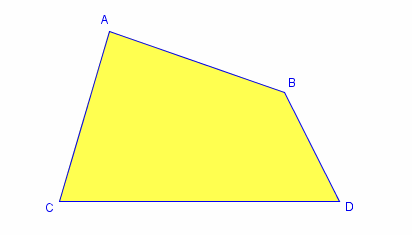
trapezium [truh-pee-zee-uh m] Word Origin noun, plural tra·pe·zi·ums, tra·pe·zi·a [truh-pee-zee-uh] /trəˈpi zi ə/.
- Geometry.
- (in Euclidean geometry) any rectilinear quadrilateral plane figure not a parallelogram.
- a quadrilateral plane figure of which no two sides are parallel.
- British.trapezoid(def 1a).
- Anatomy. a bone in the wrist that articulates with the metacarpal bone of the thumb.
Origin of trapezium 1545–55; New Latin Greek trapézion kind of quadrilateral, literally, small table, equivalent to trápez(a) table (shortening of *tetrapeza object having four feet, equivalent to tetra- four + péza foot, akin to poús, podós; see tetra-, foot) + -ion diminutive suffixRelated formstra·pe·zi·al, adjective British Dictionary definitions for trapezia trapezium noun plural -ziums or -zia (-zɪə)
- mainly British a quadrilateral having two parallel sides of unequal lengthUsual US and Canadian name: trapezoid
- mainly US and Canadian a quadrilateral having neither pair of sides parallel
- a small bone of the wrist near the base of the thumb
Derived Formstrapezial, adjectiveWord Origin for trapezium C16: via Late Latin from Greek trapezion, from trapeza table Word Origin and History for trapezia trapezium n.
1560s, from Late Latin trapezium, from Greek trapezion “irregular quadrilateral,” literally “a little table,” diminutive of trapeza “table,” from tra- “four” (see four) + peza “foot, edge,” related to pous (see foot (n.)). Before 1540s, Latin editions of Euclid used the Arabic word helmariphe. As the name of a bone in the wrist, it is recorded from 1840.
trapezia in Medicine trapezium [trə-pē′zē-əm] n. pl. tra•pe•zi•ums
- A quadrilateral having no parallel sides.
- A bone in the wrist at the base of the thumb, articulating with the first and second metacarpal, scaphoid, and trapezoid bones.
trapezia in Science trapezium [trə-pē′zē-əm] Plural trapeziums trapezia
- A four-sided plane figure having no parallel sides.
 Liberal Dictionary English Dictionary
Liberal Dictionary English Dictionary